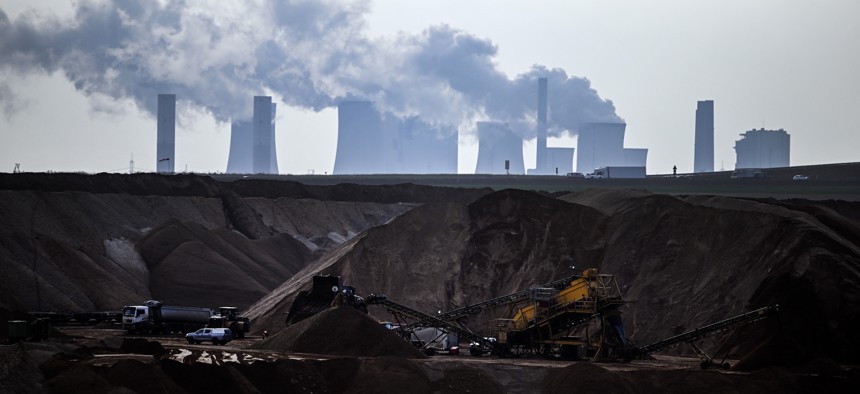
Coal is mined and burned in northwestern Germany's Garzweiler open-pit mine and Neurath power plant in April 2022. Federico Gambarini/picture alliance via Getty Images
Climate Change Isn’t a Threat Multiplier. It’s the Main Threat.
Over the next six months, the defense community should champion and help plan a whole-of-society “hyper-response.”
Why hasn’t humanity responded to climate change—currently on track to produce global catastrophe—with the same intensity in which we respond to military threats? And is there a way to reorient the defense sector to enable and support a whole-of-society effort to protect our planet’s ability to support life as we know it?
One barrier is the way we think. Research finds that humanity’s “deep frames”—worldviews wired into our neural circuity over a lifetime, and which influence perception and decision-making at the sub-conscious level—hinder our capacity to understand new kinds of threats. These frames, often reinforced by those they benefit, influence security posture and institutional design.
This helps explain why the climate crisis is generally approached as a scientific, economic, and governance issue. IPCC reports employ social scientists, not security practitioners, to tease out climate-security issues. Legitimate concerns about securitization help ensure that climate response remains a strictly civil matter.
In the security sector itself, thinking about climate change is dominated by Sherri Goodman’s original framing of global warming as a “threat multiplier” introduced in a 2007 CNA report. For example, John Conger, a former Pentagon comptroller who now leads the Center for Climate and Security, writes that global warming is one ingredient of many risk factors; it “amplifies” other threats but is not the threat. Likewise, NATO’s brand-new 2022 Strategic Concept describes climate as both a “challenge” and a “threat multiplier,” last in a list of 14 security concerns.
Consequently, defense forces the world over are ambling toward lower-emission technologies, preparing for more natural disasters, and debating the near-term consequences of a degrading global-security environment. These debates miss the main point: that we are moving toward “a shift to a climate inhospitable for most forms of life” that will bring ecological collapse, violence, hardship, and death on nearly unimaginable scales.
Is there another way? What if the security sector could be persuaded to think of climate change as the central threat? Could it help chart a pathway to a safe planet?
A new approach called PLAN E frames climate and environmental issues not as an influence upon the threat environment, but as the main threat—indeed, a new kind dubbed the hyperthreat—subjected to a military-style analysis and response-planning process. The rationale for this approach and the methods used are outlined in the Spring 2022 issue of the Journal of Advanced Military Studies. To prompt broader imagining of what a new threat posture could look like, Marine Corps University has published a notional PLAN E grand strategy.
To be precise, PLAN E is the conceptualization and planning phase of a six-phase “hyper-response”: a civilian-led, whole-of-society mobilization (note: not militarization). The overall mission is to reach “Destination Safe Earth” by 2100: a habitable planet “safe” for all people and all species.
The strategy was informed by analysis of the hyperthreat’s center of gravity (the key characteristic that provides its power) which was assessed as being its freedom of action, enabled by its unknowability and human hesitancy to respond. The human activity that fuels the hyperthreat is overwhelmingly legal, has social license, and is understood as legitimate business or security activity, though it also includes covert hidden actions. Responsibility for and contributions to subsequent “slow violence” are obscured.
The hyper-response strategy envisions three lines of effort: making the hyperthreat visible and knowable; reducing its freedom of action; and achieving mass and speed of response. Some of its specific proposals include a climate emergency peace treaty which would allow all nations to prepare to counter and survive the hyperthreat; a “Point Force” to address economic and legal dimensions; and a planetary security task force to lead a globe-spanning clean-up effort to save “Ally One” (nature) through ecological restoration.
The hyper-response could be described as a predominantly bottom-up solution; it operates from homes, communities, and workplaces, and up to the geopolitical level. It shifts resources and decision-making capacity to key locations and local governments while also working to restore nation-state agency and fostering eco-multilateralism and regional solutions.
This is not just a way to account for the fears and risks associated with securitization of the climate response; it is in fact crucial to success. The enormous amount of work needed in a short time can only be done by harnessing Earth’s large human population; call it a “humans-as-ants” strategy. Yet traditional military forces will also have key roles: creating the stable conditions that allow the civil hyper-response to work, while contributing capability to support it.
If the defense sector can help bring about the hyper-response, it will re-align with its fundamental raison d'être—protecting its people and territories—in the most important battle humanity has even known. But scientific realities mean the clock is ticking. Policy makers should immediately fund PLAN E—the planning phase—so that we can begin to execute the hyper-response early next year.




